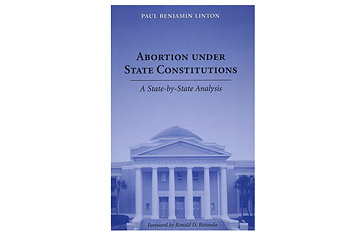
Abortion Under State Constitutions by Paul Benjamin Linton
Abortion under State Consititutions: A State-by-State Analysis
By Paul Bejamin Linton
Carolina Academic Press, 610 pages
The latest shot in the abortion wars is not a new law or a court case. It is a fat blue-covered tome entitled Abortion under State Consititutions: A State-by-State Analysis by Paul Benjamin Linton. Although intended — as indicated by its $75 price tag — for libraries, it could become one of the country's most thumbed-through tomes if the Republicans win in November and take steps to overturn the Supreme Court ruling that protects abortion rights, Roe v. Wade.
Anyone on a pro-choice mailing list is acquainted with documents like the Center for Reproductive Rights' 124-page What if Roe Fell or NARAL's "Who Decides" web-compilation of state profiles. But Linton's work represents a whole new level of play; and, while the book never totally acknowledges it, it's written for the opposing team.
Take Michigan, for example. What if Roe Fell's single page on the state cites its pre-Roe ban on all abortions except to save a woman's life, and notes that the Michigan Court of Appeals has ruled that subsequent state laws allowing abortions under other circumstances should not be assumed to overturn the ban. The booklet also notes the Michigan Supreme court has rejected the argument that the state's Equal Protection clause requires public funding for low-income women seeking medical abortions. It concludes that "Michigan's legislature has been and continues to be extremely anti-choice, making the state highly vulnerable to enactment of a new ban." The state entry is consequently written in red to indicate "high risk."
LInton, by contrast, devotes 11 pages to Michigan, tackling the pre-Roe ban and the appeals court ruling just for starters. From there it moves on to list four provisions in the state declaration of rights that pro-choice forces might use to assert abortion rights (including the equal protection clause). Then it provides Linton's detailed assessment of how each would fail. While he reaches the same conclusion that What if Roe Fell drew, Linton's is infinitely more finely argued. There are 70 footnotes.
In addition to offering higher definition, however, Abortion Under State Constitutions practices a subtle form of partisanship. Linton is a special counsel to the Thomas More Society, a pro-life group, and it paid for some of his research time. He proves very good at raising and explaining the state-by-state legal issues, and his careful analysis reveals a darker picture for pro-choice advocates. In the end he finds only 12 states that would be likely to recognize a woman's right to an abortion if Roe went down, while pro-choice groups generally believe there are 20. The organization of the chapter on each state — its constitution, its law and legal cases, possible pro-choice arguments and rebuttals to those argument — is more obviously useful (as some the book's p.r. material suggests) as a "road map" for pro-lifers than their foes.
Nevertheless, this is an important book for both sides, even if pro-choice supporters might have to work a bit harder to apply its lessons. There's still an even chance, too, that they'll elect a President and a party likely to render the book moot come November.
